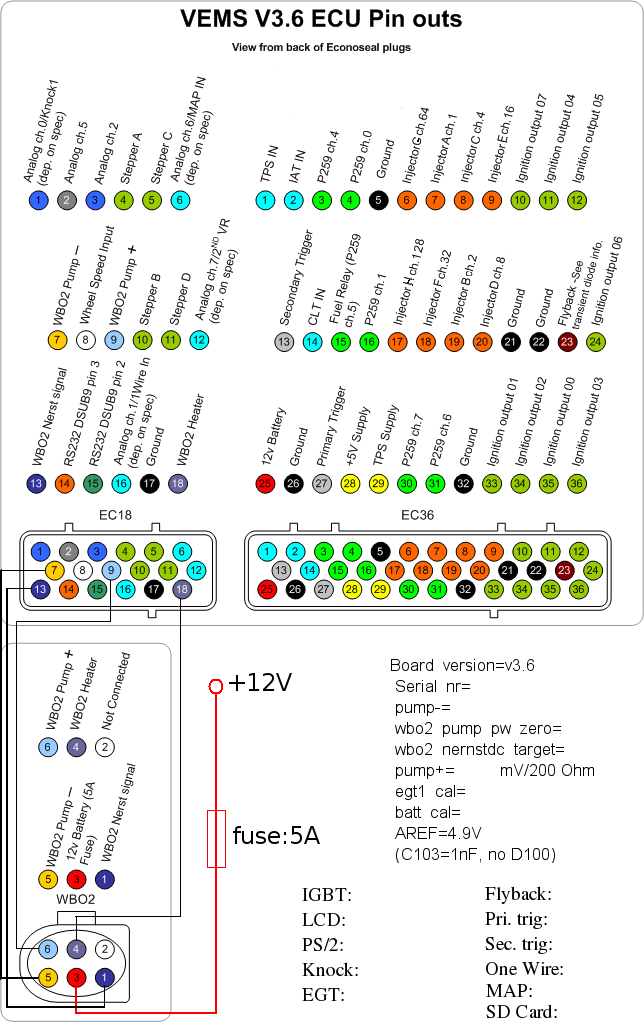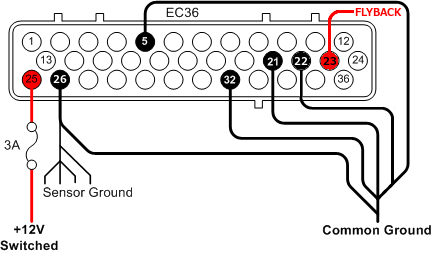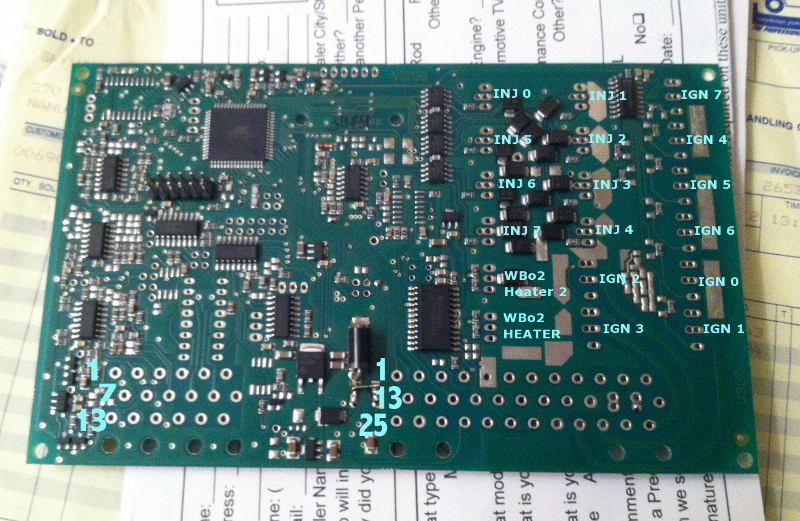You find schematic and layout files in http://www.vems.hu/files/genboardv3/ directory.
Note that you can use CTRL-F (search) to find a component by name in the PDF (not in the png) schematic or layout.
Same firmware, same tuningsoftware (VemsTune), same [help] applies to all PCB versions. Changes are mostly for manufacturability, durability against some installation "hazards", easy application of addon options (like electronic throttle or low-Z injector driver; multiple wheelspeed inputs or multiple extra-analog inputs; 3 or 4 trigger inputs when needed).
- v3.1
- [v3.1 schematic] in PNG format. 259kB
- [v3.1 schematic] in PDF format. 868kB. Effectively the same as v3.2 (v3.2 has some separate 5V regulators where v3.1 has L1,L2 or trace continuity from the main 5V)
- [v3.1 board top side] in PDF format. 890kB
- [v3.1 board bottom side] in PDF format. 817kB
- v3.2
- [v3.2 schematic] in PDF format. 390kB
- [v3.2 board top side] in PDF format 580kB
- [v3.2 board bottom side] in PDF format 580kB
- [chip orientation, bottom] and [chip orientation, top]
- v3.3
- Warning: 2 labels misplaced/swapped in the sectrig section, JP5 is actually the TRIGG2_HALL_CONN sectrig cam-HALL input, and JP20 is actually the TRIGG2_VR_CONN sectrig VR input going into LM1815 pin3 !
- [v3.3 schematic] in PDF format. 802kB Note: See Build Procedures Section Three for note on AVCC wiring (missing 33 Ohm resistor)
- [v3.3 board top side] in PDF format 1MB
- [v3.3 board bottom side] in PDF format 900kB
- v3.5
- [v3.5] layout in pdf format. The F1 throughole pads for regenerating fuse (same as R19 SMD pads) right from EC36/25 pin make the layout more suitable to use a PTC (eg. 3A 30V) for added voltage spike protection ( perhaps even some reverse supply polarity protection, but this is not guaranteed). No other changes. No schematic change at all.
- v3.6
- [v3.6] layout and schematic pdf.
- only small change is AudiTrigger/CamHALLInverter onboard, find Q13 on the schematic. Q13 is on the bottom side of the board around the middle, at the 3+2 pinheader group.
- Note that the small Q13 SOT23 NPN inverter transistor is NOT populated by default, but normally bypassed (short between base and collector).
- populated for InputTrigger/AudiTrigger when 3 triggers are in use. See [shop text] for the actually used input for your chosen HW setup
- theoretically (but almost never in practice, only if negotiated during/before ordering) Q13 can also be used for custom use eg. mcp3208 analog input pin protection when used for digital input, eg. on/off button.
- v3.7
- The only difference between the v3.6 and v3.7 is that the footprints of the TO-220 FET's are changed to mount the active flyback pcb. (You can use the v3.6 schematic and pcb layout.)
- v3.8
- [v3.8] schematic pdf.
- The EC18 analog inputs (as most often requested, eg. 1 wheelspeed + 1-WBO2 is more common than 2-WBO2 and 2 wheelspeed) were connected by PCB trace and protection.
- The 6 p259 outputs (EC36) also got diode protection...
- onboard NPN (inverter+protection) output for ETC (electronic throttle bridge output driver)
- no functional or software change.
- Input-trigger circuits unchanged (input-trigger circuits component layout same as v3.6). By default primary trigger VR pullup resistor slightly weaker than before: R30=27k (not 18k) which allows signal detection for those VR sensors that have high resistance and low input signal (an otherwise unfortunate combination). Easy to apply stronger pullup when needed (eg a 47k pullup resistor to +5V: internally or externally), eg. for strong, but somewhat noisy VR signal.
The standard EC18 wiring (since 2009-09-29):


- [more printouts for v3.x]
- [ v3.x pin information] in PDF format. 356kB.
- GenBoard/VerThree/PinOut
- GenBoard/VerTwo/CircuitDiagrams has schematics for the v2.x boards
Advanced users - only for manufacturing
There are some bin/categories.* files in CVS (see GenBoard/ManuFacturing) that in some cases override component values found on the schematic (mostly supply capacitors).
FET orientation
All the TO220 switches on GenBoard/VerThree have the same orientation (at least electrically, because some people mount them below the PCB and some mount them above).
- S (source) is the GND5 for all switches
- D is the switched point that goes to EconoSealIII connector (this point jumps to several 100 Volts when ignition transformer is driven by IGBT, so it can kill you ! Similar thing happens if you forget about injector FlyBack, but that usually kills the FETs before you)
- G is the gate, which controls the device. There is always a resistor before it (usually 22 ohm installed for PWMing setup, and 1000 Ohm for nonPWM-ed FETs and all IGBTs) and some controlling device (like AVR, FETdriver or ign259 chip). The diodes parallel with the IGBT gate resistors are not necessary.
But you see this on the schematic anyway.
Here is a diagram illustrating the driver chip locations on the circuit board relative to channel number:

See also